
The Battle of Blenheim fought on 13 August [O.S. 2 August] 1704, was a major battle of the War of the Spanish Succession. The overwhelming Allied victory ensured the safety of Vienna from the Franco-Bavarian army, thus preventing the collapse of the reconstituted Grand Alliance.
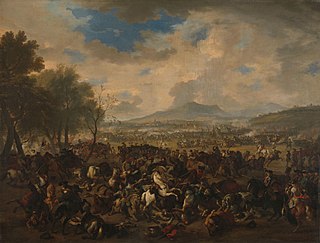
The Battle of Ramillies, fought on 23 May 1706, was a battle of the War of the Spanish Succession. For the Grand Alliance – Austria, England, and the Dutch Republic – the battle had followed an indecisive campaign against the Bourbon armies of King Louis XIV of France in 1705. Although the Allies had captured Barcelona that year, they had been forced to abandon their campaign on the Moselle, had stalled in the Spanish Netherlands and suffered defeat in northern Italy. Yet despite his opponents' setbacks Louis XIV wanted peace, but on reasonable terms. Because of this, as well as to maintain their momentum, the French and their allies took the offensive in 1706.
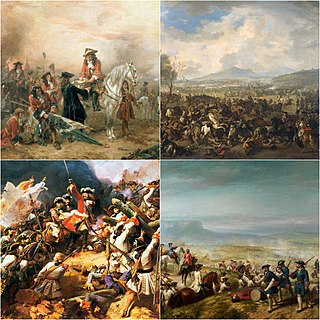
The War of the Spanish Succession was a European great power conflict fought between 1701 and 1714. The immediate cause was the death of the childless Charles II of Spain in November 1700, which led to a struggle for control of the Spanish Empire among supporters of the claimant Bourbon and Habsburg dynasties. His official heir was Philip of Anjou, a grandson of Louis XIV of France, whose main backers were France and most of Spain. His rival, Archduke Charles of Austria, was supported by the Grand Alliance, whose primary members included Austria, the Dutch Republic, and Great Britain. Significant related conflicts include the 1700 to 1721 Great Northern War, and Queen Anne's War in North America.

General John Churchill, 1st Duke of Marlborough, 1st Prince of Mindelheim, 1st Count of Nellenburg, Prince of the Holy Roman Empire, was an English soldier and statesman. From a gentry family, he served as a page at the court of the House of Stuart under James, Duke of York, through the 1670s and early 1680s, earning military and political advancement through his courage and diplomatic skill. He is known for never having lost a battle.
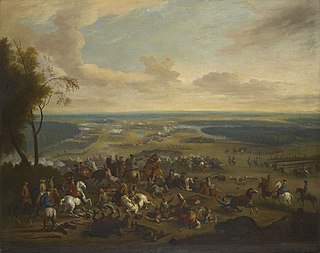
The Battle of Malplaquet took place on 11 September 1709 during the War of the Spanish Succession, near Taisnières-sur-Hon in modern France, then part of the Spanish Netherlands. A French army of around 75,000 men, commanded by the Duke of Villars, engaged a Grand Alliance force of 86,000 under the Duke of Marlborough. In one of the bloodiest battles of the 18th century, the Allies won a narrow victory, but suffered heavy casualties.

James FitzJames, 1st Duke of Berwick was a French Royal Army officer and nobleman who was the illegitimate son of James II of England by Arabella Churchill, the sister of John Churchill, 1st Duke of Marlborough. Berwick was a successful general in the service of Louis XIV.

The Battle of Oudenarde, also known as the Battle of Oudenaarde, was a major engagement of the War of the Spanish Succession, pitting a Anglo-Dutch force consisting of eighty thousand men under the command of the Duke of Marlborough and Prince Eugene of Savoy against a French force of eighty-five thousand men under the command of the Duc de Bourgogne and the Duc de Vendôme, the battle resulting in a great victory for the Grand Alliance. The battle was fought near the city of Oudenaarde, at the time part of the Spanish Netherlands, on 11 July 1708. With this victory, the Grand Alliance ensured the fall of various French territories, giving them a significant strategic and tactical advantage during this stage of the war. The battle was fought in the later years of the war, a conflict that had come about as a result of English, Dutch and Habsburg apprehension at the possibility of a Bourbon succeeding the deceased King of Spain, Charles II, and combining their two nations and empires into one.

Lieutenant-General William Cadogan, 1st Earl Cadogan, was a British Army officer, diplomat, politician and peer. He began his active military service during the Williamite War in Ireland in 1689 and ended it with the suppression of the 1715 Jacobite Rebellion. A close associate and confidant of the Duke of Marlborough, he was also a diplomat and Whig politician who sat in the English and British House of Commons from 1705 until 1716, when he was raised to the peerage as Baron Cadogan.
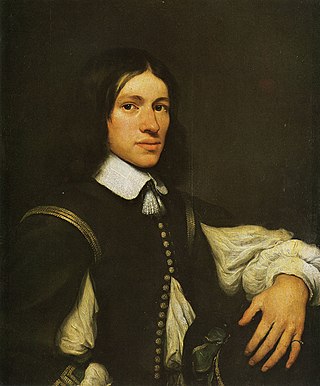
Anthonie Heinsius was a Dutch statesman who served as Grand Pensionary of Holland from 1689 to his death in 1720. Heinsius was an able negotiator and one of the greatest and most obstinate opponents of the expansionist policies of Louis XIV of France. He was one of the driving forces behind the anti-French coalitions of the Nine Years' War (1688–97) and the War of the Spanish Succession (1701–14).

Henry de Nassau, Lord Overkirk was a Dutch States Army officer and nobleman who was a second cousin of William III of England. He would come to play a prominent role in wars against the Kingdom of France, and led the Dutch army during the battles of Ramillies and Oudenarde. While Lord of Ouwerkerk and Woudenberg in the Netherlands, the English called him "Lord Overkirk" or "Count Overkirk".

The Battle of Ekeren, which took place on 30 June 1703, was a battle of the War of the Spanish Succession. A Bourbon army of around 24,000 men, consisting of troops from France, Spain and Cologne, surrounded a smaller Dutch force of 12,000 men, which however managed to break out and retire to safety.

The siege of Lille was the salient operation of the 1708 campaign season during the War of the Spanish Succession. After an obstinate defence of 120 days, the French garrison surrendered the city and citadel of Lille, commanded by Marshal Boufflers, to the forces of the Duke of Marlborough and Prince Eugene.
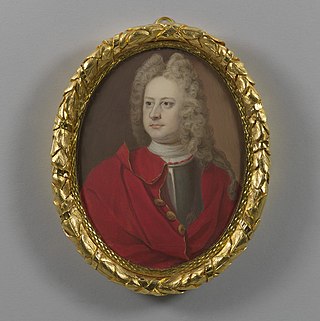
General John Richmond Webb, of Biddesden House, Ludgershall, Wiltshire, was a British general and Tory politician who sat in the House of Commons from 1695 to 1724. Politically he was a Hanoverian Tory who supported the Hanoverian Succession rather than the rival Jacobite movement.

The Siege of Ghent was the last operation of the 1708 campaign season during the War of the Spanish Succession. After successfully taking Lille shortly before, the Duke of Marlborough moved his forces onto the town of Ghent where after a 12-day siege the town's governor, Count Charles de La Mothe-Houdancourt, surrendered.

Claude Frederic t'Serclaes, Count of Tilly was a Dutch States Army officer and nobleman. He took part in the Franco-Dutch War, Nine Years' War and the War of the Spanish Succession and proved a brave and capable cavalry general. In 1708 he became the de facto supreme commander of the Dutch army, and led the Allied forces together with the Duke of Marlborough and Eugene of Savoy.
Charles, comte de la Mothe Houdancourt was a French Lieutenant-General.

Frederick Christiaan van Reede, 2nd Earl of Athlone was a Dutch States Army officer, diplomat and nobleman who fought during the Nine Years' War and the War of the Spanish Succession.

The siege of Tournai was a siege of the city of Tournai, then part of the Kingdom of France, between 28 June and 3 September 1709. A Grand Alliance army under the British Duke of Marlborough successfully forced the surrender of the French garrison during the War of the Spanish Succession.

Daniël Wolf baron van Dopf was a Dutch States Army officer and nobleman. He was, among other things, general of the cavalry of the Dutch army during the War of the Spanish Succession, Quartermaster general of that army, and later commander and governor of the fortress of Maastricht.

The assault on Brussels or siege of Brussels occurred during the War of the Spanish Succession, from 22 to 27 November 1708 involving French and pro-Bourbon Spanish troops under Maximilian of Bavaria against the garrison and citizens of the city of Brussels.





















